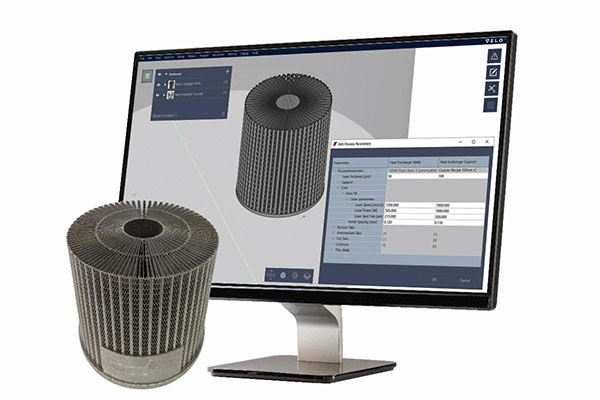Velo3D Releases Flow Developer for its Software
This is designed to simplify the migration of additive manufacturing projects to Velo3D’s fully integrated solution.

Developer is available for users of Flow 7.0, the latest version of Velo3D’s print preparation software that turns traditional design files into print files. Image courtesy of Velo3D.
Latest News
February 28, 2024
Velo3D, Inc. has released Developer, a new offering in the company’s Flow print preparation software line that unlocks control of the parameters used in 3D printing. With the flexibility of Flow Developer, users can transfer their experience from previous projects, develop new material processes, and control their optimization objectives. This is designed to simplify the migration of additive manufacturing projects to Velo3D’s fully integrated solution.
Developer is available for users of Flow 7.0, the latest version of Velo3D’s print preparation software that turns traditional design files into print files. Developer grants editor-level access to print parameters, giving companies maximum flexibility and control when working with their Velo3D additive manufacturing solution, according to Velo3D. With this access, users can import parameters they have developed, optimize default parameters for specific application needs, and develop parameter sets supporting new material development for novel solutions and specific applications. Once a part that was produced using Developer has been qualified, users can scale production leveraging the control, quality, and repeatability of Velo3D’s additive manufacturing solution.
“It can be a challenge to produce repeatable results across different metal 3D printers—even when they’re the same model of printer—however, Velo3D’s solution can consistently produce parts within spec across any of its printers, which provides huge benefits for companies looking to scale production of their parts,” says Additive Manufacturing Manager at Ursa Major, Thomas Pomorski.
“When our team first tested Flow Developer, we transferred parameters we developed on a non-Velo system, hoping we could easily produce the same part on Velo3D’s system and then take advantage of the scalability it provides,” Pomorski adds. “On our first try, we imported a part with highly complex, sensitive features and achieved incredible results that were within specification. Since then, we’ve accomplished the same process with other parts and in some cases, have been able to reduce print time by nearly 50% without sacrificing accuracy or quality.”
Prior to its general release, Developer has been made available to select customers for feedback, including Ursa Major, a privately funded company developing rocket propulsion technology. During this phase, engineers have been able to directly transfer their custom parameters into their Velo3D solutions with exceptional results. Developer gave early-access customers the ability to easily scale production of their parts as their applications matured from development to production.
“Velo3D’s mission has always been to provide an additive manufacturing solution that delivers repeatability from machine-to-machine, which is still a big shortcoming with legacy metal 3Dprinters,” says Brad Kreger, CEO of Velo3D. “Previously, we did this by providing pre-defined parameters within the system, which left customers wanting to know what’s inside our ‘black box’ and looking for more flexibility. When you combine Flow Developer with our ability to produce identical parts using the same print file, we strike the perfect balance between usability, repeatability, and flexibility. This has allowed these early access customers to think outside the box of conventional additive manufacturing to progress beyond their current limitations and realize true production scalability for their parts.”
Flow is a key part of Velo3D’s approach to additive manufacturing. In addition to Flow and the Sapphire family of printers, the company’s solution also includes Assure quality assurance software, which monitors a print layer by layer to ensure consistent geometric accuracy, surface finish, and material properties throughout a finished part.
For more product details, click here.
Sources: Press materials received from the company and additional information gleaned from the company’s website.
Subscribe to our FREE magazine, FREE email newsletters or both!
Latest News
About the Author
DE’s editors contribute news and new product announcements to Digital Engineering.
Press releases may be sent to them via DE-Editors@digitaleng.news.






